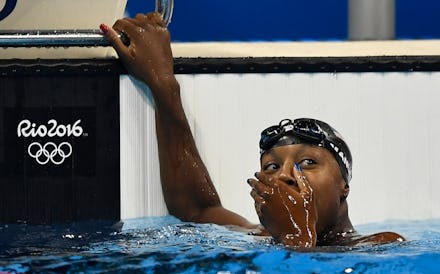After Simone Manuel's landmark Olympic win, many are reminded of McKinney pool incident

Simone Manuel became the first black woman swimmer to win an individual gold medal at an Olympic Games Thursday. The 20-year-old from Sugar Land, Texas, tied with Canada's Penny Oleksiak for first place in the 100-meter freestyle in Rio de Janeiro.
The significance of Manuel's victory was not lost on Twitter users, who were quick to applaud the historic moment:
But as others noted, this historic moment came at a cost. Many pointed to the brutal police response to black teenagers at a swimming pool in McKinney, Texas, to illustrate how Manuel's medal holds larger symbolism in the history of the United States' segregated pools:
On June 15, 2015, police officers responded to the scene of a private pool party in McKinney, a Dallas suburb. A group of black teenagers had arrived — to the chagrin of white locals — and, in some instances, started climbing the fence and pushing past security to enter.
Twelve police officers arrived on the scene. One, Eric Casebolt, was captured on video pointing his gun at the dispersing children, cursing at them and throwing one — 15-year-old Dajerria Becton — to the ground before sitting on top of her.
Here is video footage of the incident:
But even aside from this, communal swimming pools have much a longer, darker history concerning race in the United States.
Dr. Jeff Wiltse, author of Contested Waters: A Social History of Swimming Pools in America, told NPR in 2008 that cities routinely avoided building pools in black neighborhoods during the 1920s and 1930s, setting the stage for a battle over access to public space that would last for decades.
Segregation of these pools was often achieved through violence. In some cities, it was enforced by the police. In others, officials encouraged white swimmers to physically attack black swimmers to get them out of the water, punching and dunking them to force them to leave.
"In my book, I have some pictures of black Americans who literally sort of lie still on the ground with bloody heads from being pummeled to the ground, just for trying to access a swimming pool," Wiltse said.
As the federal government began enforcing integration measures in the 1960s, white people responded by building more private pools, allowing for de facto segregation that was protected under the law. The historical residue is apparent even today: According to a 2010 study commissioned by U.S.A. Swimming, over twice as many black children could not swim compared to white children.
In light of this history — and the still-raw wounds opened in McKinney — that a black girl from Texas could not only become a world-class swimmer, but an Olympic champion, is a remarkable achievement. Manuel represents one of the few bright chapters in America's sordid history with race and swimming pools — and it is one that likely will not soon be forgotten.